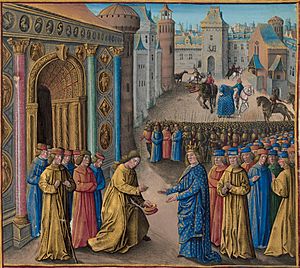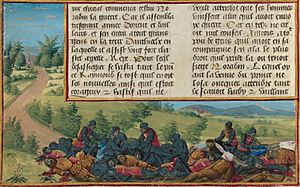Raymond of Poitiers facts for kids

Raymond of Poitiers (born around 1105, died June 29, 1149) was a powerful leader known as the Prince of Antioch. He ruled from 1136 until his death in 1149. Raymond was the younger son of William IX, who was the Duke of Aquitaine, and his wife Philippa.
Contents
Becoming the Prince of Antioch
After Prince Bohemund II of Antioch died in 1130, the Principality of Antioch needed a new ruler. Bohemund's young daughter, Constance (born 1127), was too young to rule alone. So, different people acted as her regent (someone who rules for a child). First, King Baldwin II was regent (1130–31). Then King Fulk took over (1131–35). Finally, Constance's mother, Princess Alice, was regent (1135–36).
A marriage was planned for Constance with Raymond, who was in England at the time. He left England after King Henry I died in late 1135.
King Roger II of Sicily heard that Raymond was traveling through his lands to marry Constance. Roger tried to arrest Raymond. But Raymond used clever tricks to get through southern Italy. He finally arrived in Antioch after April 19, 1136.
The church leader, Patriarch Ralph of Domfront, tricked Alice. He made her believe Raymond was there to marry her. Alice then let Raymond enter Antioch. The city's guards had been refusing him entry. The patriarch quickly married Raymond to Constance instead. Alice then left the city, and Raymond and Ralph took control.
Early Challenges and Conflicts
Raymond and Constance's first years of ruling were full of fights. They faced the Byzantine Emperor John II Comnenus. The Emperor wanted to take back Cilicia from Leo of Armenia. He also wanted to show his power over Antioch.
Raymond was forced to promise loyalty to Emperor John. He even had to agree to give up Antioch. In return, John promised to give him a new fief (land given in exchange for loyalty). This new land was supposed to be in Muslim territory east of Antioch.
In 1138, Raymond joined John on an expedition to conquer this territory. But the plan failed. The expedition ended with an unsuccessful Siege of Shaizar. Raymond wasn't eager to help the emperor gain new lands. He knew it would mean losing Antioch for himself. Emperor John went back to Constantinople without success. He had demanded that Raymond hand over the citadel (a strong fortress) of Antioch, but Raymond refused.
Struggles with Power
After this, Raymond had a disagreement with the patriarch. Raymond was annoyed by the loyalty he had been forced to show the patriarch in 1135. He also questioned if the patriarch's election was truly fair. Raymond eventually won this struggle. The patriarch was removed from his position in 1139.
In 1142, Emperor John Comnenus attacked again. But Raymond refused to give in or renew his promise of loyalty. John attacked the area around Antioch, but he couldn't defeat Raymond.
However, Raymond later demanded some towns in Cilicia from Manuel. Manuel had become emperor after John died in 1143. Raymond found that Manuel was a strong opponent. Manuel forced Raymond to make a humbling visit to Constantinople. There, Raymond again promised his loyalty. He also agreed to accept a Greek patriarch (church leader) in Antioch.
The Second Crusade and Raymond's Death
In 1144, news reached Europe that the city of Edessa had fallen. This event led to the Second Crusade. Raymond of Poitiers had already sent a group, including Hugh, Bishop of Jabala, to ask Pope Eugene III for help.
In 1149, the last year of Raymond's life, King Louis VII and his wife Eleanor of Aquitaine visited Antioch. Eleanor was Raymond's niece. Raymond wanted Louis to stay in Antioch. He hoped Louis would help conquer Aleppo and Caesarea instead of going south to Jerusalem.
King Louis quickly left Antioch, and Raymond's plans were stopped. In 1149, Raymond was killed in the Battle of Inab. This happened during a military trip against Nur ad-Din Zangi. Raymond was beheaded by Shirkuh, who was the uncle of Saladin. His head was then put in a silver box. It was sent as a gift to the Caliph Al-Muqtafi in Baghdad.
Raymond's Character and Family
A historian named William of Tyre described Raymond. He said Raymond was "a noble lord, tall and elegant." He was also "the most handsome of the princes." William called him charming, friendly, generous, and magnificent. Raymond was also very skilled in using weapons and had a lot of military experience. Even though he couldn't read or write himself, he supported writers. He was a regular churchgoer and a loyal husband. However, William also said Raymond could be stubborn, quick to anger, and unreasonable. He also loved gambling too much.
With Constance, Raymond had these children:
- Bohemond III
- Maria, who married Emperor Manuel I Komnenos
- Philippa
- Baldwin
See also
 In Spanish: Raimundo de Poitiers para niños
In Spanish: Raimundo de Poitiers para niños
| Preceded by Constance |
Prince of Antioch (with Constance) 1136–1149 |
Succeeded by Constance |


